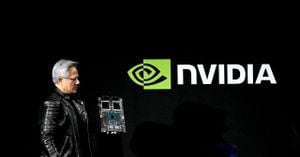For decades, Intel has been the gold standard of computing power. Known for its cutting-edge processors, it dominated the personal computer market with its reliable performance. Yet today, Intel faces significant challenges as the industry transitions to artificial intelligence (AI), leaving many to ponder, can this tech titan adapt to the next wave of innovation?
Once heralded as the king of chip manufacturing, Intel's dominance has seen cracks, particularly as AI takes center stage. The company finds itself at the crossroads due to fierce competition from rivals like Nvidia and AMD, who have successfully carved out substantial market share by prioritizing AI-specific technology and graphics processors. While Intel initially lagged behind due to its slower transition to AI and a failure to embrace specialized chips, the urgency to pivot has never been clearer.
Unlike traditional processors which focus on general-purpose computing, AI-centric chips are purpose-built to handle massive data processing and complex algorithms efficiently. Nvidia’s GPUs are now the backbone of AI applications, powering everything from autonomous vehicles to sophisticated deep learning models. By comparison, Intel’s attempts to pivot toward AI have come off as reactive and somewhat muddled. According to financial analysts, this shift is not just about technology but about market perception and strategic vision.
New CEO Pat Gelsinger, who took the helm at Intel chasing after innovation, has been vocal about steering Intel back on track amid these growing pressures. He announced plans for significant investments of over $20 billion to build new manufacturing facilities to ramp up production and meet rising demands for semiconductors within various sectors, particularly AI. Although ambitious, can Gelsinger’s strategy reposition Intel favorably?
Critics argue the company is focusing too heavily on its legacy x86 architecture instead of leveraging its vast resources to catch up with Nvidia’s lead. Market trends suggest this is not merely about improving speed but entirely reinventing how chips are developed, particularly for AI tasks. Gelsinger responded to these concerns by promising better collaboration between hardware and software teams to craft processors fine-tuned for AI workloads.
An intriguing development is Intel’s venture to develop its own AI chips, but these efforts will require time and substantial engineering resources. Building the infrastructure where these chips will thrive is also necessary, which involves creating compatible software ecosystems. The budding relationship with software developers and AI researchers will be key to maintaining relevance.
Further complicate the situation is the reality of supply chain issues, exacerbated by semiconductor shortages and geopolitical tensions. These factors have made it difficult for not just Intel but the entire tech industry to keep pace with market demands. While many companies are trying to navigate this environment, Intel's established reputation means they feel the pressure more acutely—a reflection of expectations versus current performance.
The microprocessor industry itself has experienced paradigm shifts where emerging technologies have redefined benchmarks of efficiency. For example, quantum computing represents another frontier Intel must address. Although still nascent, quantum computing could alter the competitive playing field, rendering current chips obsolete if companies like Intel do not evolve.
The move to AI is particularly timely as industries such as healthcare, automotive, finance, and consumer services rapidly adopt AI-driven solutions. Companies in these sectors increasingly depend on data analytics and predictive modeling—tasks where specialized chips exhibit marked superiority over traditional processors.
Intel is also investing heavily in developing neural processing units (NPUs) to provide foundational capabilities needed for AI applications. This realignment could present new revenue streams. The gauge of success for these NPUs will hinge not just on their computational power, but also how quickly they can be brought to market and integrated with existing systems.
While Nvidia has established itself as the go-to GPU manufacturer for AI technologies, industry watchers believe there’s still room to maneuver. Intel's extensive existing client base paired with Gelsinger’s determination to revitalize the company provides fuel for optimism. If Intel can capitalize on its legacy and pivot toward emerging markets effectively, it may be poised for resurgence, even amid such intense competition.
One glimmer of hope for Intel is its solid portfolio approaching AI through collaborations. The company announced partnerships with prominent AI startups as well as established tech giants for shared research and development purposes. These alliances could pave the way for important breakthroughs, provided the company can synchronize its field-tested innovations with the needs of the evolving AI sphere.
There’s no denying, transforming Intel’s course won’t be easy. The challenges are multifaceted: adapting to AI, recovering its innovative edge, optimizing resources, addressing competition, and managing global supply chain vulnerabilities. But if history has taught us anything, it’s somewhat of business resilience. Will Intel emerge triumphant or get overtaken by more agile competitors? Only time will tell.
Investors are keeping close tabs on Intel’s moves, hoping for signs of recovery, as shares have faced significant downturns as of late. Reports suggest the company’s market valuation has fluctuated, leading to uncertainty around its profitability. To retain investor confidence, Gelsinger must act fast. If the company can successfully transition to producing AI-oriented technologies, there could be bright horizons on the horizon.
Moving forward, embracing adaptive thinking will be critical for survival. Intel's legacy of innovation must now translate to practical solutions within the AI ecosystem. The company must challenge itself to think outside traditional chip design norms and engage small, agile teams focused solely on AI applications and collaboration—lessons learned from its competitors who are thriving today.
While uncertainty shadows the semiconductor giant, the silver lining rests on its rich history of innovation coupled with Gelsinger's ambitious vision and steps toward realigning its strategy. Time will tell if Intel can rise to the occasion and reclaim its spot as the leading force amid the AI revolution. Can this iconic company reinvent itself to not only survive but thrive once more? The eyes of the tech world remain fixed on Intel, waiting for its next move.



